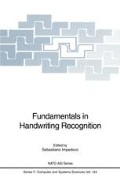Abstract
This paper presents a technique to hierarchically segment handwritten words. Handwritten words are broken down into either concave or convex segments called p-strokes (partial strokes). P-strokes are recombined to form Windows of Observation (WO), where the number of p-strokes defines the window size. Once a word is segmented into a sequence of p-strokes, window of observation of different sizes are scanned stroke-by-stroke across the word in a fully overlapped manner, producing a stream of potential characters.
Unsupervised clustering of window size 1 to 5 resulted in a codebook of 461 representative windows of observation. Secondly, supervised clustering using 25,000 handwritten alphacharacters resulted in a set of 2,525 prototypes. The segmentation and the clustering techniques are described in this paper.
Access this chapter
Tax calculation will be finalised at checkout
Purchases are for personal use only
Preview
Unable to display preview. Download preview PDF.
References
Bock, P.: The Emergence of Artificial Cognition: An Introduction to Collective Learning, World Scientific Publishing Company, 1993.
Edelman S., Flash, T., Ulmann S.: Reading Cursive Handwriting by Alignment of Letter Prototypes, International Journal of Computer Vision 303-331, 1990.
Frishkopf, L.S., and Harmon, L.D., Cherry, C.: Machine Reading of Cursive Script, Information Theory, Butterworth, London, 310–316, 1961.
Houle, G.F., Radelat, C., Resnick, S., Bock, P.: A Handwritten Word Recognition using Collective Learning Theory, Frontier of Handwriting 1993.
Lecolinet, E., Cretez, J.: A Grapheme-based Segmentation Technique for Cursive Script Recognition, Proceedings of ICDAR 91, 740-748, 1991.
Simon, J.C., Baret, O.: Formes regulières et Singulières; application à la reconnaissance de l’écriture manuscrite, CR. Académie de Paris, t. 309 (Série II) 1901-1906, 1989.
Srihari, S.N., Bozinovic, R.: A Multi-Level Perception Approach to Reading Cursive Script, Artificial Intelligence, 217-255, 1987.
Author information
Authors and Affiliations
Editor information
Editors and Affiliations
Rights and permissions
Copyright information
© 1994 Springer-Verlag Berlin Heidelberg
About this paper
Cite this paper
Houle, G.F. (1994). A Hierarchical Handwritten Word Segmentation. In: Impedovo, S. (eds) Fundamentals in Handwriting Recognition. NATO ASI Series, vol 124. Springer, Berlin, Heidelberg. https://doi.org/10.1007/978-3-642-78646-4_13
Download citation
DOI: https://doi.org/10.1007/978-3-642-78646-4_13
Publisher Name: Springer, Berlin, Heidelberg
Print ISBN: 978-3-642-78648-8
Online ISBN: 978-3-642-78646-4
eBook Packages: Springer Book Archive

